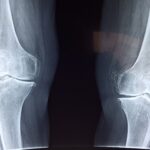 Multiple epiphyseal dysplasia, which affects the epiphysis of long bones, can show autosomal dominant and autosomal recessive inheritance patterns. The symptoms typically appear in childhood, although they sometimes do not show symptoms until adulthood. The goals of treatment in children are to prevent the early onset of osteoarthritis, improve function, and educate patients and their families about the natural history and genetic basis of the disease. Some patients present to the clinic with only non-healing and unidentified joint pain. Although multiple epiphyseal dysplasia type 5 is a rare disease with autosomal dominant inheritance in general, it can also be observed with de novo mutation, although very rarely, without a family history.
Multiple epiphyseal dysplasia, which affects the epiphysis of long bones, can show autosomal dominant and autosomal recessive inheritance patterns. The symptoms typically appear in childhood, although they sometimes do not show symptoms until adulthood. The goals of treatment in children are to prevent the early onset of osteoarthritis, improve function, and educate patients and their families about the natural history and genetic basis of the disease. Some patients present to the clinic with only non-healing and unidentified joint pain. Although multiple epiphyseal dysplasia type 5 is a rare disease with autosomal dominant inheritance in general, it can also be observed with de novo mutation, although very rarely, without a family history.
7-years-old male patient is admitted to a orthopedics outpatient clinic with complaints of joint pain, fatigue, and pain in the knees and ankles that had lasted for about 3 years. In the laboratory, there is no obvious finding other than vitamin D deficiency. The epiphyses, especially in the ankle, are dysplasic on Xray. After genetic tests multiple epiphyseal dysplasia type 5 is detected, with de novo mutation, without family histories.
Multiple epiphyseal dysplasia type 5 is a rare disease. It should be kept in mind that skeletal dysplasia should also be evaluated, although it is rarely seen in patients with persistent joint pain. Thus, it is possible to slow down the progression with early diagnosis of the patient and minimize the early surgical requirements. Read the full article here.
